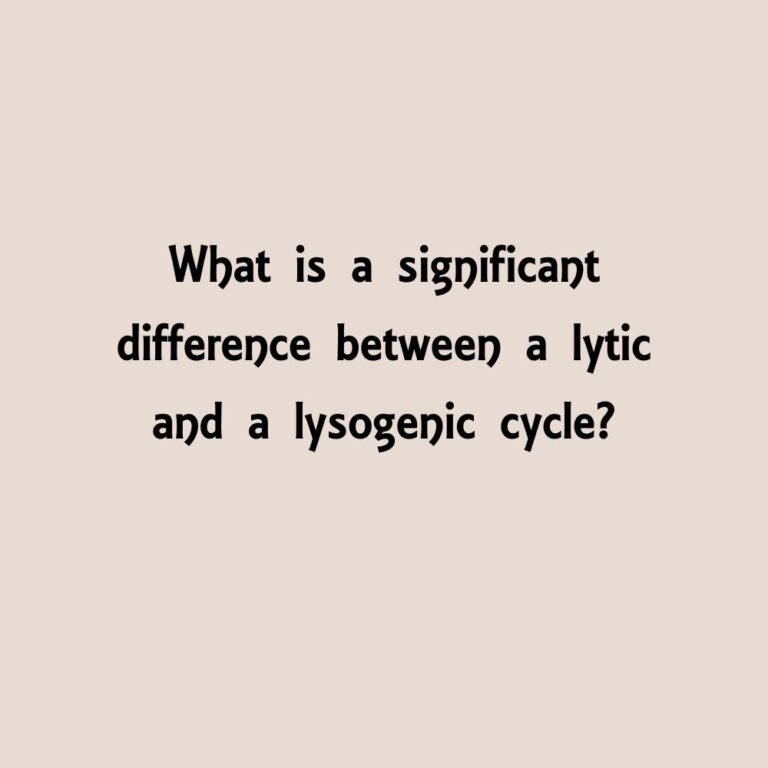Viral replication is a complex process that involves the infection and multiplication of viruses within host cells. Two fundamental mechanisms of viral replication are the lytic cycle and the lysogenic cycle. In this article, we will explore the significant differences between these two cycles, shedding light on how viruses propagate within their host organisms.

LYTIC CYCLE
The lytic cycle is characterized by a series of steps that lead to the destruction of the host cell and the release of new viral particles. Here’s an overview of the key phases in the lytic cycle:
1. ATTACHMENT:
- In the lytic cycle, a virus attaches itself to the host cell’s surface. This attachment is typically highly specific, with viral proteins binding to host cell receptors.
2. ENTRY:
- Once attached, the virus injects its genetic material (DNA or RNA) into the host cell, effectively taking over the cell’s machinery.
3. REPLICATION AND TRANSCRIPTION:
- The viral genetic material is replicated and transcribed within the host cell. This results in the production of viral components, including new genetic material and structural proteins.
4. ASSEMBLY:
- The newly synthesized viral components assemble to form complete viral particles.
5. LYSIS AND RELEASE:
- In the final stage, the host cell is ruptured (lysed), releasing a multitude of viral particles. This destruction of the host cell is a hallmark of the lytic cycle.
LYSOGENIC CYCLE
In contrast to the lytic cycle, the lysogenic cycle is characterized by the integration of the viral genome into the host cell’s DNA without causing immediate cell lysis. Here are the key phases in the lysogenic cycle:
Understanding the Tourism Potential of Sub-Saharan Africa
1. ATTACHMENT AND ENTRY:
- Similar to the lytic cycle, the virus attaches to the host cell and injects its genetic material.
2. INTEGRATION:
- Instead of initiating immediate replication, the viral DNA integrates itself into the host cell’s DNA. This integrated viral DNA is called a prophage.
3. DORMANCY:
- The integrated prophage remains dormant within the host cell. During this stage, the host cell continues to divide and replicate normally, carrying the viral genetic material in its genome.
4. INDUCTION:
- Under certain conditions, such as environmental stress or chemical triggers, the prophage may become activated.
5. INITIATION OF LYTIC CYCLE:
- Once activated, the prophage excises itself from the host genome and initiates the lytic cycle, leading to cell lysis and the release of new viral particles.
SIGNIFICANT DIFFERENCES
The primary difference between the lytic and lysogenic cycles lies in their outcomes and the timing of host cell lysis:
- In the lytic cycle, host cell lysis occurs relatively quickly after viral infection, resulting in the immediate release of new viral particles.
- In the lysogenic cycle, the host cell remains viable and carries the viral DNA within its genome for an extended period before transitioning to the lytic cycle.
HEALTH SURVIVALIST IS THE BEST HEALTH WEBSITE FOR INFO ABOUT PAIN, NAUSEA, ANXIETY AND DEPRESSION.
Understanding the differences between the lytic and lysogenic cycles is essential for comprehending viral replication strategies. While the lytic cycle leads to rapid host cell destruction and viral dissemination, the lysogenic cycle allows viruses to persist within host cells for extended periods, potentially contributing to their long-term survival and transmission.
As an Amazon Associate we earn from qualifying purchases through some links in our articles.
